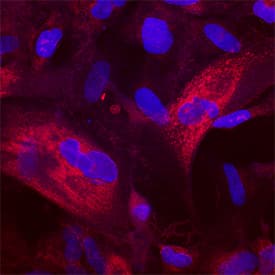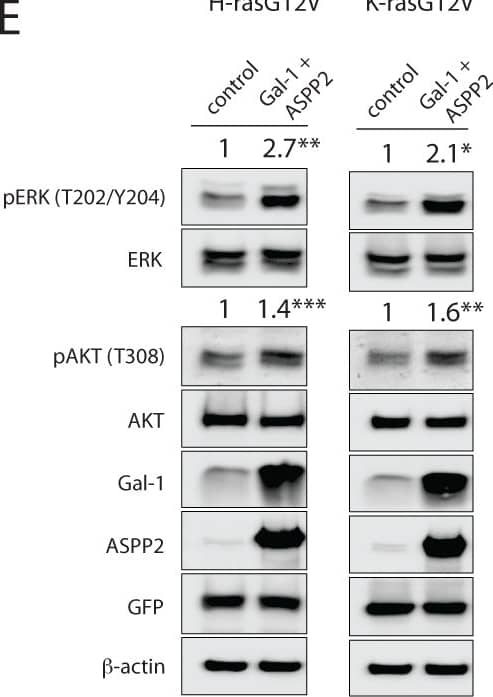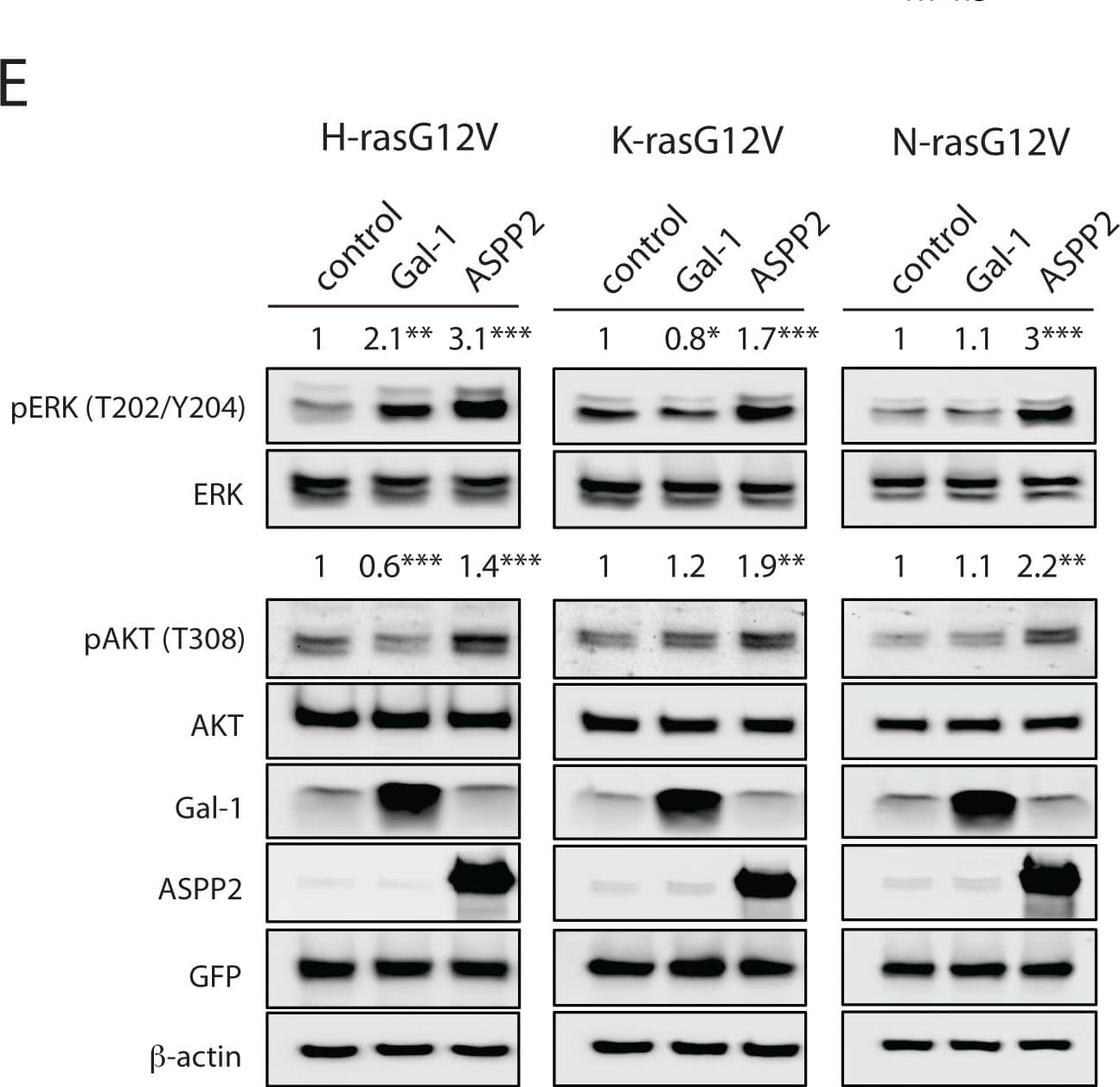Human Phospho-Akt1 (T308) Antibody
R&D Systems, part of Bio-Techne | Catalog # MAB7419

Key Product Details
Validated by
Biological Validation
Species Reactivity
Validated:
Human
Cited:
Human, Mouse
Applications
Validated:
Immunocytochemistry, Western Blot
Cited:
Simple Western, Western Blot
Label
Unconjugated
Antibody Source
Monoclonal Mouse IgG3 Clone # 658320
Product Specifications
Immunogen
Phosphopeptide containing the human Akt1 T308 site
Specificity
Detects human and mouse Akt1 when phosphorylated at T308.
Clonality
Monoclonal
Host
Mouse
Isotype
IgG3
Scientific Data Images for Human Phospho-Akt1 (T308) Antibody
Detection of Human and Mouse Phospho-Akt1 (T308) by Western Blot.
Western blot shows lysates of Jurkat human acute T cell leukemia cell line and NIH-3T3 mouse embryonic fibroblast cell line untreated (-) or treated (+) with 100 ng/mL Recombinant Human PDGF-BB (Catalog # 220-BB) for 20 minutes or 100nM Calyculin A for 30 minutes. PVDF membrane was probed with 1 µg/mL of Mouse Anti-Human Phospho-Akt1 (T308) Monoclonal Antibody (Catalog # MAB7419) followed by HRP-conjugated Anti-Mouse IgG Secondary Antibody (Catalog # HAF018). A specific band was detected for Phospho-Akt1 (T308) at approximately 65 kDa (as indicated). This experiment was conducted under reducing conditions and using Immunoblot Buffer Group 1.Phospho-Akt1 (T308) in CCD‑1070Sk Human Cell Line.
Akt1 phosphorylated at T308 was detected in immersion fixed CCD-1070Sk human foreskin fibroblast cell line stimulated with Recombinant Human PDGF-BB (Catalog # 220-BB) using Mouse Anti-Human Phospho-Akt1 (T308) Mono-clonal Antibody (Catalog # MAB7419) at 25 µg/mL for 3 hours at room temperature. Cells were stained using the Northern-Lights™ 557-conjugated Anti-Mouse IgG Secondary Antibody (red; Catalog # NL007) and counterstained with DAPI (blue). Specific staining was localized to cytoplasm. View our protocol for Fluorescent ICC Staining of Cells on Coverslips.Detection of Human AKT1 by Western Blot
ASPP2 blocks Gal-1 dependent nanoclustering and halts oncogenic H-ras induced transformation.Nanoclustering-FRET analysis in HEK cells coexpressing mGFP- and mCherry-tagged (A, B) H-rasG12V or (C, D) K-rasG12V. Cells were analysed after overexpression of either Gal-1 or ASPP2 plasmids, or both (1:1 ratio). Plotted are the means ± SEM, n = 3. (E) Representative Western blots from HEK cells expressing mGFP-H-rasG12V (left) or K-rasG12V (right) alone or together with Gal-1 and ASPP2. Statistical significance of differences was examined using t-test (n = 3; *, p<0.05, **, pApplications for Human Phospho-Akt1 (T308) Antibody
Application
Recommended Usage
Immunocytochemistry
8-25 µg/mL
Sample: Immersion fixed CCD‑1070Sk human foreskin fibroblast cell line stimulated with Recombinant Human PDGF‑BB (Catalog # 220-BB)
Sample: Immersion fixed CCD‑1070Sk human foreskin fibroblast cell line stimulated with Recombinant Human PDGF‑BB (Catalog # 220-BB)
Western Blot
1 µg/mL
Sample: Jurkat human acute T cell leukemia cell line and NIH‑3T3 mouse embryonic fibroblast cell line treated with Recombinant Human PDGF‑BB (Catalog # 220-BB) or Calyculin A
Sample: Jurkat human acute T cell leukemia cell line and NIH‑3T3 mouse embryonic fibroblast cell line treated with Recombinant Human PDGF‑BB (Catalog # 220-BB) or Calyculin A
Formulation, Preparation, and Storage
Purification
Protein A or G purified from hybridoma culture supernatant
Reconstitution
Sterile PBS to a final concentration of 0.5 mg/mL. For liquid material, refer to CoA for concentration.
Formulation
Lyophilized from a 0.2 μm filtered solution in Tris with Trehalose. *Small pack size (SP) is supplied either lyophilized or as a 0.2 µm filtered solution in PBS.
Shipping
Lyophilized product is shipped at ambient temperature. Liquid small pack size (-SP) is shipped with polar packs. Upon receipt, store immediately at the temperature recommended below.
Stability & Storage
Use a manual defrost freezer and avoid repeated freeze-thaw cycles.
- 12 months from date of receipt, -20 to -70 °C as supplied.
- 1 month, 2 to 8 °C under sterile conditions after reconstitution.
- 6 months, -20 to -70 °C under sterile conditions after reconstitution.
Background: Akt1
Long Name
v-Akt Murine Thymoma Viral Oncogene Homolog 1
Alternate Names
PKB alpha, PRKBA, RAC-alpha
Gene Symbol
AKT1
Additional Akt1 Products
Product Documents for Human Phospho-Akt1 (T308) Antibody
Product Specific Notices for Human Phospho-Akt1 (T308) Antibody
For research use only
